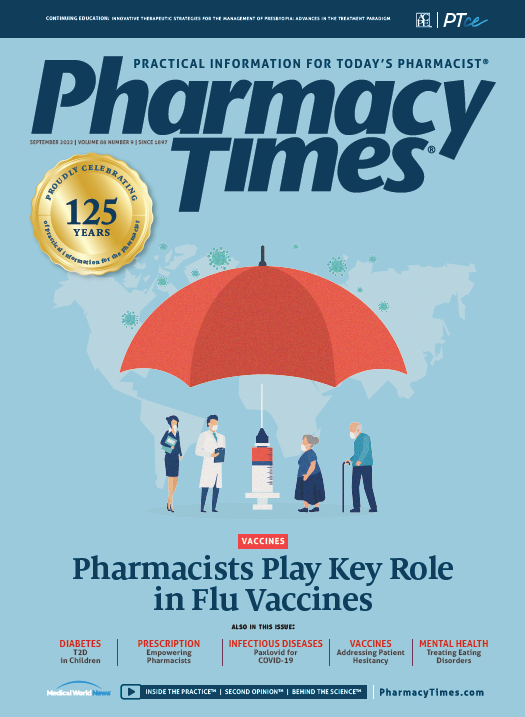News
Article
Pharmacy Times
Mitigate Risk for Errors Involving Paxlovid
Author(s):
Take steps to safeguard prescribing, dispensing, and patient use of the COVID-19 antiviral medication.
The FDA and the Institute for Safe Medicaiton Practices have received numerous reports of errors related to Paxlovid (nirmatrelvir and ritonavir).
Paxlovid is indicated for the treatment of mild to moderate COVID-19 in patients 12 years or older who weigh at least 40 kg, have tested positive for SARS-CoV-2, and are at elevated risk for progression to severe COVID-19, including hospitalization or death. The reports have mentioned pre- scribing or dispensing the wrong strength, improper renal dosing, and self-administration errors.
Paxlovid Packaging Configurations
Paxlovid is available in 2 configurations. For patients with normal renal function (estimated glomerular filtration rate [eGFR] ≥90 mL/min) or mild renal impairment (eGFR <90 mL/min but ≥to 60 mL/min), Paxlovid is available in a carton of 30 tablets contained in 5 daily-dose blister cards. Each blister card contains 4 nirmatrelvir tablets (150 mg each) and 2 ritonavir tablets (100 mg each). Patients should take 2 tablets of nirmatrelvir (150 mg each for a total of 300 mg) and 1 tablet of ritonavir (100 mg) in the morning and the same dose in the evening. Patients with severe renal impairment (eGFR <30 mL/min) should not receive the drug.
When Paxlovid first became available, pharmacists had to remove 1 of the 2 nirmatrelvir tablets for morning and eve- ning doses from each of the blister cards before dispensing the drugs to patients with moderate renal impairment. In some cases, extra tablets were not removed or pharmacies removed ritonavir instead of nirmatrelvir. To mitigate these risks, in April 2022, cartons of Paxlovid for patients with moderate renal impairment became available with reduced-dose blister packages designed to provide just 1 tablet of nirmatrelvir (150 mg) and 1 tablet of ritonavir (100 mg) for twice-daily administration. Each carton contains 20 tablets in 5 daily-dose blister cards.
Reported Errors
Many of the errors reported occurred when patients took the medication and generally involved taking the wrong tablets (eg, 3 of nirmatrelvir but no ritonavir, 1 of nirmatrelvir and 2 of ritonavir, or the entire day’s dose at one time). Dispensing errors involved giving the carton with reduced-dose blister packages to patients with mild renal impairment or normal renal function. Several reported errors involved improper renal dosing, such as prescribing or dispensing Paxlovid to patients with severe renal impairment. Other errors included ordering the standard dose for patients with moderate renal impairment, not checking concomitant drug use or renal function to avoid drug-drug interactions, prescribing the incorrect quantity (eg, 30 tablets for moderate renal impairment dosing), and providing directions to take 2 tablets twice a day in conflict with the instructions on the package prescribed.
Safety Recommendations
Increase physician awareness. Educate physicians about the availability of reduced-dose blister packages for patients with moderate renal impairment. Remind them to avoid prescribing and dispensing Paxlovid to patients with severe renal impairment.
Check the electronic health record (EHR) and prescribing system configuration. Check EHR or prescribing system to see how the dose- and tablet-strength fields are displayed. On drop-down menus, it is safest to list the strength of Paxlovid as a 300-mg and 100-mg dose pack for normal renal function and as a 150-mg and 100-mg dose pack for moderate renal impairment.
Provide clinical decision support. Include dose guidance for Paxlovid in prescribing systems. For instance, mention the reduced dosing required for patients with moderate renal impairment.
Confirm renal function. Check the patient’s renal function before dispensing Paxlovid. Use the FDA’s Paxlovid Patient Eligibility Screening Checklist Tool for Prescribers to support clinical decision-making and screen for significant drug interactions (fda.gov/media/158165/ download). Document the patient’s most recent eGFR and date on prescriptions. Pharmacists without access to the patient’s medical record must contact the prescriber if this information is not included.
Avoid communicating the dose by tablet or blister color. Do not refer to the tablets as pink (nirmatrelvir) and white (ritonavir) or by the color of the blister package because this can cause patients to misunderstand which medications they should take.
Educate patients. Designate Paxlovid prescriptions as needing mandatory patient education. Show patients how the drug is labeled on the blister pack and teach them about the 2 medications they’ll be taking. Encourage them to remove each tablet just prior to taking it (ie, do not transfer to pillbox). Give patients the Fact Sheet for Patients, Parents, and Caregivers (fda. gov/media/155051/download).
About The Author
Michael J. Gaunt, PharmD, is a senior director of error reporting programs and editor at the Institute for Safe Medication Practices (ISMP) in Horsham, Pennsylvania. He also serves as the editor of the monthly ISMP Medication Safety Alert! Community/Ambulatory Care newsletter.






